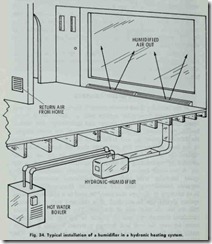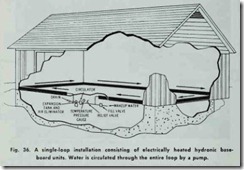CIRCULATING PUMPS
In forced hot water heating systems, circulating (booster) pumps are used to force or circulate the hot water through the pipes. Fig. 29 illustrates a typical location of one of these pumps on a return line.
Circulating pumps for hot water heating systems are designed
and built to handle a wide range of pumping capacities. They will vary in size from small booster-type pumps with a 5 gpm capacity to those capable of handling thousands of gallons per minute.
In order to select a suitable pump for a hot water heating
system (i.e. one that will produce maximum flow without over loading the pump motor), H is necessary to correctly match the operating characteristics of the pump to the requirements of the heating system.
The correct location of a pump is crucial to its successful operation. Pump manufacturers will usually give detailed informa tion in their literature on this point. Circulating pumps with mechanical seals are very common in hot water heating systems.
DRAINAGE
There should be a provision for adequate drainage facilities in a hot-water heating system during shut-down periods. If drain age is not provided for, there is always the danger of the unheated water freezing in the pipes during extreme cold weather. Chemical “antifreeze” solutions have also been developed for use in hot water heating systems in an attempt to prevent the water from freezing during shut-down periods.
Pitching all pipes to a central point is an important considera
tion when designing the system, because it is essential to effective drainage.
HEAT EMITTING UNITS
The hot water in both gravity and forced hot-water heating sys tems is circulated through the pipes to the radiators or other heat emitting units from which the heat is transferred into ,the room.
Conventional radiators (Fig. 30) are often set on the floor or mounted on the wall. Many examples of these can still be found in older buildings. Some attempts have been made to conceal radiators by recessing them in the wall of the room or enclosing them (partially or entirely) in cabinets. Recessed radiators must have some sort of insulation between them and the wall. One-inch thick insulation board, a sheet of reflective insulation, or a combi nation of both is recommended for this purpose. If the radiator is partially or entirely covered with a cabinet, then openings should be provided at both the top and bottom of the cabinet for air circulation.
Convectors usually consist of finned tubes enclosed in a cabinet (Fig. 31) or baseboard unit (Fig. 32) with openings at the top and bottom. The hot water circulates through the tubes which radiate heat. Air enters the bottom of the cabinet or baseboard and exits through the openings in front.
Baseboard radiator units (Fig. 33) consists of long, narrow tubes directly behind a baseboard face. The hot water flows through the tubes, heats the baseboard face, and the heat is radiated from the surface into the room. Make sure that the metal cover of the baseboard unit is not too thin (an indication of a cheaply built unit). Thin covers are easily dented and water tempera-ture changes in the heating element can cause a thin baseboard cover .to be noisy.
AIR CONDITIONING
Air conditioning can be added to a structure heated by a hot water heating system in a number of different ways. Central air conditioning can be added with the use of the so-called split system installation. The evaporator-blower unit is installed in the attic and the condensing unit (compressor and condenser) is located outside the house. The boiler and heat emitting units are shown in black.
Chapters 8, 9, 10 and 11, Volume 3 provide details for a variety of different types of air conditioning systems, many of which are suitable for adding to houses and buildings with existing hot-water heating systems.
MOISTURE CONTROL
If the humidity level in a structure is too low, the dry air will absorb moisture from other sources such as plaster, wood floors, wood furniWre, fabrics (e.g. drapes and upholstery), and human bodies. As a result, the plaster tends to crack, the wood shrinks, the fabrics become dry and brittle, and the sensitive membranes in the nose and throat dry out faster than the human body can replace the moisture. These problems caused by dry air can be avoided by maintaining an adequate amount of moisture in the air. A hot-water heating system will generally maintain an ade quate humidity level without the additional assistance of a separate humidifying unit. The humidifier illustrated in Fig. 34 is an example of the type that could be used in a hydronic heating system should one be required. It is designed with a hot water coil on the air inlet side of the unit. The heated boiler water circulates through this coil. A blower in the unit draws filtered room air over the coil and through a wetted rotating pad. The moist air is then circulated through the rooms by the blower. The humidifier is controlled by a room humidistat.
ELECTRICALLY HEATED SYSTEMS
Compact electric-fired boilers operate essentially the same way as a heating plant powered by coal, oil, or gas are also avail able for hot water heating systems. These boilers are characterized not only by their compactness, but also by their quiet operating characteristics.
The extreme compactness of an electric-fired hot water heating system is illustrated in Fig. 35. The heat exchanger, expansion tank, and operating controls are all mounted on the wall in a relatively small space.
A central heating unit (e.g. an electric-fired boiler) can be eliminated in some systems by using ·thermostatically controlled
electric heating components in the baseboard units. Fig. 36 illus trates a system of this type. Note that there is no boiler. The water is circulated ·through the system by a pump, and a uniform tem perature can be maintained by ·the heating element in each baseboard.
The heating system illustrated in Fig. 36 is a single-loop installation. It is also possible to divide the whole system into a series of sealed or closed units filled with a water and antifreeze solution operating on the gravity flow principle. Each unit could be controlled by a thermostat, or several units by a wall thermo stat. The advantage of this .type of installation is that the heating capacity can be easily increased if the house or building is enlarged.
ADVANTAGES AND DISADVANTAGES OF HOT-WATER HEATING SYSTEMS
There are several distinct advantages to using hot water heating as opposed to steam heating. For one thing, it is more flexible than low pressure (above atmospheric) steam systems because the temperature may be widely varied. Due to the low working temperature of the water, the heat from a hot water system is relatively mild and the room atmosphere is not robbed of any of its healthful qualities. Moreover, these systems function as reservoirs for storing heat because the radiators remain warm a considerable length of time after the fire in the boiler is extinguished.
A principal disadvantage of using hot water heating is the initial high installation cost as compared to steam and warm-air he3ting systems.
![Fig.-30.-Conventional--cast-iron--ra[2] Fig.-30.-Conventional--cast-iron--ra[2]](http://machineryequipmentonline.com/hvac-machinery/wp-content/uploads/2020/04/Fig.-30.-Conventional-cast-iron-ra2_thumb.jpg)
![Fig.-31.-finned-tube--connector-in-a[1] Fig.-31.-finned-tube--connector-in-a[1]](http://machineryequipmentonline.com/hvac-machinery/wp-content/uploads/2020/04/Fig.-31.-finned-tube-connector-in-a1_thumb.jpg)
![fig.-32.-Baseboard--radiator--units[2] fig.-32.-Baseboard--radiator--units[2]](http://machineryequipmentonline.com/hvac-machinery/wp-content/uploads/2020/04/fig.-32.-Baseboard-radiator-units2_thumb.jpg)
![Fig.-33.-xamp1es-of-baseboard-radiat[2] Fig.-33.-xamp1es-of-baseboard-radiat[2]](http://machineryequipmentonline.com/hvac-machinery/wp-content/uploads/2020/04/Fig.-33.-xamp1es-of-baseboard-radiat2_thumb.jpg)

![Fig.-35.-Compact-electric-fired-boil[2] Fig.-35.-Compact-electric-fired-boil[2]](http://machineryequipmentonline.com/hvac-machinery/wp-content/uploads/2020/04/Fig.-35.-Compact-electric-fired-boil2_thumb.jpg)
